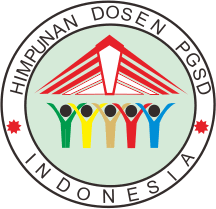Penerapan model pembelajaran kooperatif tipe two stay two stray (tsts) untuk meningkatkan pemahaman konsep bangun ruang pada siswa kelas v sekolah dasar
Abstract
Abstract. The purpose of this research is improving understanding of geometry concept by applicating Two Stay Two Stray cooperative learning model. This researchis Classroom Action Research with two cycles. The subjects of this research were students of the 5th students at11 Ngringo Elementary School of Jaten subdistrict Karanganyar in the academic year of 2017/2018, totalling 32 students. This research uses data collection techniques in the form of interview, observation, i.e. planning, implementation, observation and reflection. The analysis of the data used is the interactive analysis model of Miles-Huberman. The first cycle resulting in a percentage of 40,62% in classical, and the study continued with the second cycle with the percentage of 82,25% in classical terms. Based on the result of the research, it can be conclude that through the application of Two Stay Two Stray cooperative learning model can improve understanding of geometry concept of 5th grade students of 11 Ngringo Elementary School of Jaten subdistrict Karanganyar in the academic year of 2017/2018.
Keywords
Full Text:
PDFReferences
M. Ali 2010, Guru dalam Proses Belajar Mengajar. (Bandung: Sinar Baru Algesindo).
D. A. Putri, R. Winarni, and A. Surya, “Analisis kesulitan belajar pemecahan masalah matematika berdasarkan newman procedure pada peserta didik kelas V sekolah dasar,” Didakt. Dwija Indria, vol. 9, no. 3, 2021, doi: https://doi.org/10.20961/ddi.v9i3.49193.
C. H. Muhammad Nur Arifin 2018, “Peningkatan Pemahaman Konsep Bangun Datar Dengan Menggunakan Media Realia Pada Pembelajaran Matematika Pada Siswa Sekolah Dasar,” Didakt. Dwija Indria, vol. 6, no. 5, pp. 29–34.
F. Shadiq 2014, Pembelajaran Matematika. (Yogyakarta: Graha Ilmu).
Trianto 2010, Mendesain Model Pembelajaran Inofatif- Progresif, Konsep, Landasan, dan Implementasi pada Kurikulum Tingkat Satuan Pendidikan (KTSP). Jakarta: Kencana Predana Media Group.
R. Cahyani, S. Kamsiyati, and I. R. W. Atmojo, “Peningkatan keterampilan representasi penyajian data melalui model pembelajaran kooperatif tipe numbered head together ( nht ) pada peserta didik kelas iv sekolah dasar,” J. Pendidik. Indones., vol. 7, no. 2, 2021, doi: https://doi.org/10.20961/jpi.v7i1.48718.
A. R. Gestiani and S. Istiyati, “Implementasi model two stay two stray untuk meningkatkan pemahaman konsep kegiatan ekonomi pada siswa kelas IV sekolah dasar,” Didakt. Dwija Indria, vol. 9, no. 4, pp. 3–7, 2021, doi: https://doi.org/10.20961/ddi.v9i4.49359.
D. W. S 2015, “Peningkatan Pembelajaran Konsep Gaya Melalui Model Pembelajaran Two Stay Two Stray (TSTS) pada Siswa Kelas V SD Negeri Karangasem 3 Tahun ajaran 2014/2015,” Universitas Sebelas Maret.
S. Ayu 2014, “Peningkatan Pemahaman Konsep Sifat-Sifat Magnet Melalui Penerapan Model Pembelajaran Kooperatif Tipe Two Stay Two Stray (TSTS) pada Siswa Kelas V SD Negeri Pengkol 01 Tahun Ajaran 2013/2014,” Universitas Sebelas Maret.
M. Huda 2014, Model-model Pengajaran Pembelajaran. (Yogyakarta: Pustaka Pelajar).
A. Shoimin 2016, Model Pembelajaran Inovatif Dalam Kurikulum 2013. (Yogyakarta: Ar-Ruzz Media).
A. Suprijono 2009, Cooperative Learning: Teori & Aplikasi Paikem. (Yogyakarta: Pustaka Pelajar).
S. dan Wina 2011, Strategi Pembelajaran Berorientasi Standar Proses Pendidikan. (Jakarta: Kencana).
F. Nuraini and F. Kristin 2017, “Penggunaan Model Problem Based Learning (PBL) untuk Meningkatkan Hasil Belajar IPA Siswa Kelas 5 SD,” Mitra Pendidik., vol. 1, pp. 369–379,.
M. Fathurrohman 2015, Model-model Pembelajaran Inovatif. (Yogyakarta: Ar-Ruzz Media).
Refbacks
- There are currently no refbacks.



